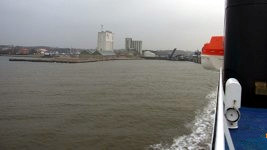
The Fehmarnbelt tunnel will connect Rødbyhavn on the Danish island of Loran to Puttgarden in northern Germany. Ferries operated through the strait until 2019, with trains being loaded directly onto the ferries, which was a precious experience for me on my 2015 trip.
Initially, a bridge was planned, but this was eventually changed to a tunnel and construction began. When it comes to tunnels, drilling holes in the bedrock under the sea comes to mind. However, this tunnel is an immersed tunnel, in which tubular concrete is made onshore beforehand and then submerged and placed underwater. It takes only 10 minutes to cross the strait, whereas before it took an hour by ferry. Also, the distance travelled through the tunnel is shorter than the route via the Jutland Peninsula and Odense in Denmark. Shorter journey times are expected to contribute to reducing CO2 emissions.
Even though I agree with the SDGs and climate action, I feel nostalgic that the atmosphere of the train getting onto the ferry is gone and it can pass through there in a flash. The bridge would have offered me a better view, anyway.

¶When it’s finished, the Fehmarnbelt tunnel, which will link Denmark and Germany, will be the world’s longest immersed tunnel. In an important milestone, dredging the trench for the 18-kilometer, or 11.1-mile, tunnel is now half finished. […] Full text is here. Referenced from Travel AWAITS, 1 June, 2022
Click Here to Read the Full Original Article at Looking back now…
